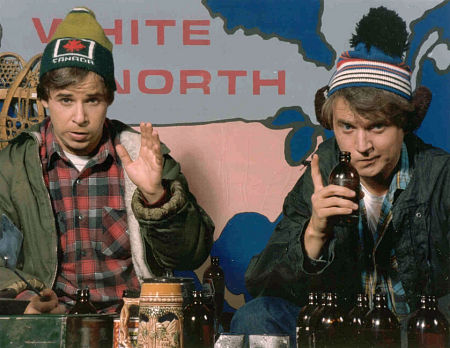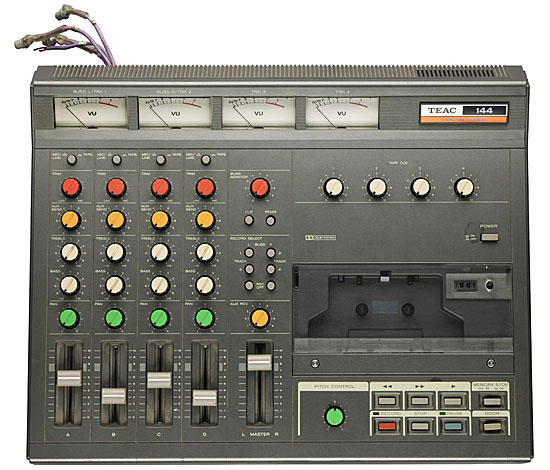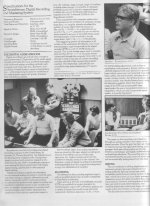A local engineer looped "Tusk" back on itself at a perfect point and made a 90min. version. He did the same thing with "Stairway to Heaven" that worked even better. That was back when even commercial FM stations had some fun.
HA!
Yeah, had some great FM stations back in the 70's and 80's.
se
Well, I heard the original mix-downs, between analog and digital. I still feel that the digital final mix had the inherent problem that digital had at the time, (at least) and this added a negative factor that people were not accustomed to at the time, for sure, and I predicted that this would effect the success of the record.
While the musical compositions were perhaps not to the standard of 'Rumors' they were pretty good, and pure inertia should have provided more sales.
Of course, that is my personal and professional opinion made at that time when I, like Ed Simon today, was really 'cooking' in the pro audio business.
While the musical compositions were perhaps not to the standard of 'Rumors' they were pretty good, and pure inertia should have provided more sales.
Of course, that is my personal and professional opinion made at that time when I, like Ed Simon today, was really 'cooking' in the pro audio business.
How is that related to dither?
It is related to the "nice" looking FFT of 4-bit A/D of sine with dither. It looks "nice" only for the reason of large memory + averaging.
SNR = 6.02N + 1.76dB + 10log(M/2)
N ... number of bits
M ... number of samples in the FFT record
The best examples of 30 ips recording that I had something to do with came from Wilson Audio Recordings. 'S'Wonderful Jazz' with the Eddie Graham Trio, and later releases that came from the 30 ips master recorder that I made for Dave Wilson.
Ultimately, the recorder was leased to Sheffield Records to make a recording of the Moscow Philharmonic Orchestra, in the '80's in Moscow, itself. This came out pretty well.
Ultimately, the recorder was leased to Sheffield Records to make a recording of the Moscow Philharmonic Orchestra, in the '80's in Moscow, itself. This came out pretty well.
It is related to the "nice" looking FFT
You still don't get it?
We don't care about the FFT, OK.
Condemnation without examination is prejudice.
I think you're right. It's not as if the mass consumer market is terribly discriminating when it comes to recording quality.
Look at Nebraska, one of Bruce Springsteen's best selling albums containing perhaps his most popular song, Born in the USA.
It was recorded on a Tascam PortaStudio (a "prosumer" four track, and at the time, cassette-based recorder) using a pair of Shure SM-57 mics.
An externally hosted image should be here but it was not working when we last tested it.
se
Looking at my copy of Nebraska right now. "Recorded in New Jersey by Mike Batlin on a Teac Tascam Series 144 4-track cassette recorder..."
Dark album, no Born in the USA on it.
No. Born in the USA came out later, and was on the "Born in the USA" Album.........................Look at Nebraska, one of Bruce Springsteen's best selling albums containing perhaps his most popular song, Born in the USA................
allmusic ((( Born in the U.S.A. > Overview )))
Last edited:
Looking at my copy of Nebraska right now. "Recorded in New Jersey by Mike Batlin on a Teac Tascam Series 144 4-track cassette recorder..."
Dark album, no Born in the USA on it.
You're right. My bad.
Thanks for the correction.
se
Bad Steve.
Nebraska only sold three copies here in Canada.
Oh, like anybody cares about Canada.
Take off, hoser!

se
The best examples of 30 ips recording that I had something to do with came from Wilson Audio Recordings. 'S'Wonderful Jazz' with the Eddie Graham Trio, and later releases that came from the 30 ips master recorder that I made for Dave Wilson.
Ultimately, the recorder was leased to Sheffield Records to make a recording of the Moscow Philharmonic Orchestra, in the '80's in Moscow, itself. This came out pretty well.
Preferring orchestral music, I've ordered copies of the three volumes of Moscow Sessions (CD).

Look forward to listening!
.
An externally hosted image should be here but it was not working when we last tested it.
Just found this image.
-
Keith Johnson of Reference Recordings?
.
Last edited:
In order for this to not get too confusing, let me elaborate on what I know about the 'Moscow Sessions'. My machine was used as well as at least one other (pictured) by Stan Ricker, Lincoln Mayorga, and Keith Johnson.
Keith and I have never gotten along too well, as he declined to work with me on the Mobile Fidelity Mastering machines, even when I asked him to contribute to the project, and years later, without me knowing, had bid on making the 'Ultramaster' for Dave Wilson, which would have left me out of the project. I have known him professionally, and respected his knowledge of magnetic recording, reading his original work as early as 1968. However, he has rarely given me much personal input, and I have to presume that he would prefer to remain that way. The Ultramaster was used for some of the recordings, but not all of them, I was told by Keith Johnson.
When the unit came back to the USA, it was sent to me to 'clean up and test'. It was interesting that it seemed to be coated in tobacco smoke.
Later, Lincoln Mayorga, personally thanked me for making the machine, when I ran into him at an audio conference some time later.
Keith and I have never gotten along too well, as he declined to work with me on the Mobile Fidelity Mastering machines, even when I asked him to contribute to the project, and years later, without me knowing, had bid on making the 'Ultramaster' for Dave Wilson, which would have left me out of the project. I have known him professionally, and respected his knowledge of magnetic recording, reading his original work as early as 1968. However, he has rarely given me much personal input, and I have to presume that he would prefer to remain that way. The Ultramaster was used for some of the recordings, but not all of them, I was told by Keith Johnson.
When the unit came back to the USA, it was sent to me to 'clean up and test'. It was interesting that it seemed to be coated in tobacco smoke.
Later, Lincoln Mayorga, personally thanked me for making the machine, when I ran into him at an audio conference some time later.
That photo of Stan Ricker reminds me of the appearance of his face on the Delos DMS series of LPs mastered from digital recordings. My scan is from DMS3002, a 1979 recording of trumpet music, including the Vivaldi concerto for two trumpets.
The back of the gatefold is marked by grandiose claims for the sound (astonishing clarity & intimate presence) from the 16-bit, 50Ks/s recording.
Suspicion mounts on reading that the recording equipment was set up at the recording location using a distortion analyser, and no mention made of any listening.
Playing this record today leaves one wondering what they monitored it with. It is dull and 2-dimensional.
The same Vivaldi concerto was released the year before on the Decca (London) 'Editions de L'oiseau Lyre' label, DSLO-544. The difference could hardly be more stark - this record creates enormous 3D space effects and vivid presence.
Compare DSLO-544 yourself to the DELOS or any similar digital LP (they are easy and cheap to buy) and you'll see - assuming you use a moderately good playback setup, properly aligned.
The back of the gatefold is marked by grandiose claims for the sound (astonishing clarity & intimate presence) from the 16-bit, 50Ks/s recording.
Suspicion mounts on reading that the recording equipment was set up at the recording location using a distortion analyser, and no mention made of any listening.
Playing this record today leaves one wondering what they monitored it with. It is dull and 2-dimensional.
The same Vivaldi concerto was released the year before on the Decca (London) 'Editions de L'oiseau Lyre' label, DSLO-544. The difference could hardly be more stark - this record creates enormous 3D space effects and vivid presence.
Compare DSLO-544 yourself to the DELOS or any similar digital LP (they are easy and cheap to buy) and you'll see - assuming you use a moderately good playback setup, properly aligned.
Attachments
Keith and I have never gotten along too well, as he declined to work with me on the Mobile Fidelity Mastering machines, even when I asked him to contribute to the project, and years later, without me knowing, had bid on making the 'Ultramaster' for Dave Wilson, which would have left me out of the project. I have known him professionally, and respected his knowledge of magnetic recording, reading his original work as early as 1968. However, he has rarely given me much personal input, and I have to presume that he would prefer to remain that way.
That's too bad- he is a very talented recording engineer and his work has sounded marvelous.
- Status
- Not open for further replies.
- Home
- Member Areas
- The Lounge
- John Curl's Blowtorch preamplifier part II


